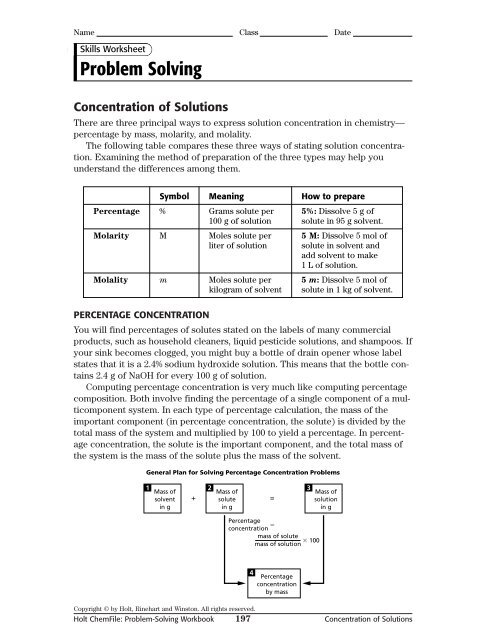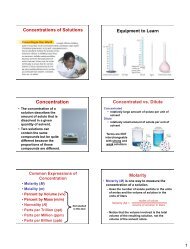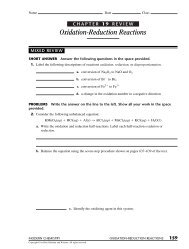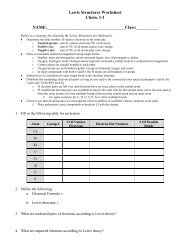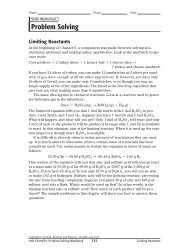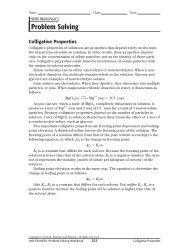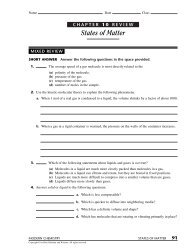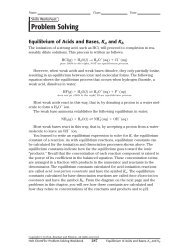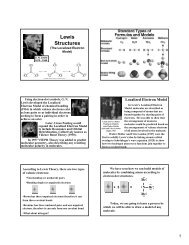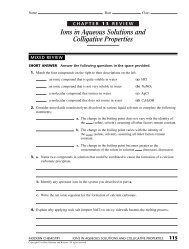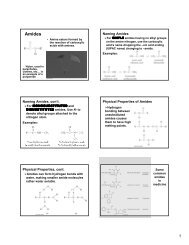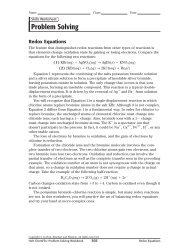Concentration of Solutions
Concentration of Solutions
Concentration of Solutions
Create successful ePaper yourself
Turn your PDF publications into a flip-book with our unique Google optimized e-Paper software.
Name Class Date<br />
Skills Worksheet<br />
Problem Solving<br />
<strong>Concentration</strong> <strong>of</strong> <strong>Solutions</strong><br />
There are three principal ways to express solution concentration in chemistry—<br />
percentage by mass, molarity, and molality.<br />
The following table compares these three ways <strong>of</strong> stating solution concentration.<br />
Examining the method <strong>of</strong> preparation <strong>of</strong> the three types may help you<br />
understand the differences among them.<br />
Symbol Meaning How to prepare<br />
Percentage %<br />
Grams solute per 5%: Dissolve 5 g <strong>of</strong><br />
100 g <strong>of</strong> solution solute in 95 g solvent.<br />
Molarity<br />
Molality<br />
M<br />
m<br />
Moles solute per<br />
liter <strong>of</strong> solution<br />
Moles solute per<br />
kilogram <strong>of</strong> solvent<br />
5 M: Dissolve 5 mol <strong>of</strong><br />
solute in solvent and<br />
add solvent to make<br />
1 L <strong>of</strong> solution.<br />
5 m: Dissolve 5 mol <strong>of</strong><br />
solute in 1 kg <strong>of</strong> solvent.<br />
PERCENTAGE CONCENTRATION<br />
You will find percentages <strong>of</strong> solutes stated on the labels <strong>of</strong> many commercial<br />
products, such as household cleaners, liquid pesticide solutions, and shampoos. If<br />
your sink becomes clogged, you might buy a bottle <strong>of</strong> drain opener whose label<br />
states that it is a 2.4% sodium hydroxide solution. This means that the bottle contains<br />
2.4 g <strong>of</strong> NaOH for every 100 g <strong>of</strong> solution.<br />
Computing percentage concentration is very much like computing percentage<br />
composition. Both involve finding the percentage <strong>of</strong> a single component <strong>of</strong> a multicomponent<br />
system. In each type <strong>of</strong> percentage calculation, the mass <strong>of</strong> the<br />
important component (in percentage concentration, the solute) is divided by the<br />
total mass <strong>of</strong> the system and multiplied by 100 to yield a percentage. In percentage<br />
concentration, the solute is the important component, and the total mass <strong>of</strong><br />
the system is the mass <strong>of</strong> the solute plus the mass <strong>of</strong> the solvent.<br />
General Plan for Solving Percentage <strong>Concentration</strong> Problems<br />
1<br />
Mass <strong>of</strong><br />
solvent<br />
in g<br />
<br />
2<br />
Mass <strong>of</strong><br />
solute<br />
in g<br />
<br />
3<br />
Mass <strong>of</strong><br />
solution<br />
in g<br />
Percentage<br />
concentration <br />
mass <strong>of</strong> solute<br />
100<br />
mass <strong>of</strong> solution<br />
Copyright © by Holt, Rinehart and Winston. All rights reserved.<br />
4<br />
Percentage<br />
concentration<br />
by mass<br />
Holt ChemFile: Problem-Solving Workbook 197 <strong>Concentration</strong> <strong>of</strong> <strong>Solutions</strong>
Name Class Date<br />
Problem Solving continued<br />
Sample Problem 1<br />
What is the percentage by mass <strong>of</strong> a solution made by dissolving 0.49 g <strong>of</strong><br />
potassium sulfate in 12.70 g <strong>of</strong> water?<br />
Solution<br />
ANALYZE<br />
What is given in the problem?<br />
What are you asked to find?<br />
the mass <strong>of</strong> solvent, and the mass <strong>of</strong> solute,<br />
K 2 SO 4<br />
the concentration <strong>of</strong> the solution expressed as<br />
a percentage by mass<br />
Items<br />
Mass <strong>of</strong> solvent<br />
Data<br />
12.70 g H 2 O<br />
PLAN<br />
What step is needed to calculate the concentration <strong>of</strong> the solution as a percentage<br />
by mass?<br />
Divide the mass <strong>of</strong> solute by the mass <strong>of</strong> the solution and multiply by 100.<br />
1<br />
Mass <strong>of</strong> water in g <br />
Mass <strong>of</strong> solute 0.49 g K 2 SO 4<br />
<strong>Concentration</strong> (% by mass) ? %<br />
2<br />
Mass <strong>of</strong> K 2<br />
SO 4<br />
in g<br />
<br />
3<br />
Mass <strong>of</strong> K 2<br />
SO 4<br />
solution in g<br />
percentage solute mass<br />
concentration<br />
100<br />
solution mass<br />
4<br />
Percentage<br />
K 2<br />
SO 4<br />
by mass<br />
given<br />
g K 2<br />
SO 4 100<br />
percentage concentration g K2 SO 4<br />
g H 2<br />
O<br />
given<br />
given<br />
COMPUTE<br />
0.49 g K<br />
percentage concentration 2 SO<br />
4<br />
100 3.7% K 2 SO 4<br />
0.49 g K 2 SO 4 12.70 g H 2 O<br />
EVALUATE<br />
Are the units correct?<br />
Yes; percentage K 2 SO 4 was required.<br />
Is the number <strong>of</strong> significant figures correct?<br />
Yes; the number <strong>of</strong> significant figures is correct because the data had a minimum<br />
<strong>of</strong> two significant figures.<br />
Copyright © by Holt, Rinehart and Winston. All rights reserved.<br />
Holt ChemFile: Problem-Solving Workbook 198 <strong>Concentration</strong> <strong>of</strong> <strong>Solutions</strong>
Name Class Date<br />
Problem Solving continued<br />
Is the answer reasonable?<br />
Yes; the computation can be approximated as 0.5/13 100 3.8%.<br />
Practice<br />
1. What is the percentage concentration <strong>of</strong> 75.0 g <strong>of</strong> ethanol dissolved in 500.0 g<br />
<strong>of</strong> water? ans: 13.0% ethanol<br />
2. A chemist dissolves 3.50 g <strong>of</strong> potassium iodate and 6.23 g <strong>of</strong> potassium<br />
hydroxide in 805.05 g <strong>of</strong> water. What is the percentage concentration <strong>of</strong> each<br />
solute in the solution? ans: 0.430% KIO 3 , 0.765% KOH<br />
3. A student wants to make a 5.00% solution <strong>of</strong> rubidium chloride using 0.377 g<br />
<strong>of</strong> the substance. What mass <strong>of</strong> water will be needed to make the solution?<br />
ans: 7.16 g H 2 O<br />
4. What mass <strong>of</strong> lithium nitrate would have to be dissolved in 30.0 g <strong>of</strong> water in<br />
order to make an 18.0% solution? ans: 6.59 g LiNO 3<br />
Copyright © by Holt, Rinehart and Winston. All rights reserved.<br />
Holt ChemFile: Problem-Solving Workbook 199 <strong>Concentration</strong> <strong>of</strong> <strong>Solutions</strong>
Name Class Date<br />
Problem Solving continued<br />
MOLARITY<br />
Molarity is the most common way to express concentration in chemistry. Molarity<br />
is the number <strong>of</strong> moles <strong>of</strong> solute per liter <strong>of</strong> solution and is given as a number followed<br />
by a capital M. A 2 M solution <strong>of</strong> nitric acid contains 2 mol <strong>of</strong> HNO 3 per<br />
liter <strong>of</strong> solution. As you know, substances react in mole ratios. Knowing the<br />
molar concentration <strong>of</strong> a solution allows you to measure a number <strong>of</strong> moles <strong>of</strong> a<br />
dissolved substance by measuring the volume <strong>of</strong> solution.<br />
General Plan for Solving Molarity Problems<br />
1<br />
Mass <strong>of</strong><br />
solute<br />
in g<br />
Convert<br />
using the<br />
molar mass<br />
<strong>of</strong> the solute.<br />
2<br />
Amount<br />
<strong>of</strong> solute<br />
in mol<br />
M <br />
4<br />
moles solute<br />
liter solution<br />
Molar<br />
concentration,<br />
M<br />
3<br />
Volume<br />
<strong>of</strong> solution<br />
in L<br />
Copyright © by Holt, Rinehart and Winston. All rights reserved.<br />
Holt ChemFile: Problem-Solving Workbook 200 <strong>Concentration</strong> <strong>of</strong> <strong>Solutions</strong>
Name Class Date<br />
Problem Solving continued<br />
Sample Problem 2<br />
What is the molarity <strong>of</strong> a solution prepared by dissolving 37.94 g <strong>of</strong><br />
potassium hydroxide in some water and then diluting the solution to a<br />
volume <strong>of</strong> 500.00 mL?<br />
Solution<br />
ANALYZE<br />
What is given in the problem?<br />
What are you asked to find?<br />
the mass <strong>of</strong> the solute, KOH, and the final volume<br />
<strong>of</strong> the solution<br />
the concentration <strong>of</strong> the solution expressed as<br />
molarity<br />
Items<br />
Mass <strong>of</strong> solute<br />
Moles <strong>of</strong> solute<br />
Molar mass <strong>of</strong> solute*<br />
Volume <strong>of</strong> solution<br />
<strong>Concentration</strong> (molarity)<br />
Data<br />
37.94 g KOH<br />
? mol KOH<br />
56.11 g/mol<br />
500.00 mL<br />
? M<br />
* determined from the periodic table<br />
PLAN<br />
What steps are needed to calculate the concentration <strong>of</strong> the solution as molarity?<br />
Determine the amount in moles <strong>of</strong> solute; calculate the moles per liter <strong>of</strong> solution.<br />
1<br />
Mass <strong>of</strong> KOH<br />
in g<br />
multiply by the<br />
inverted molar<br />
mass <strong>of</strong> KOH<br />
Volume <strong>of</strong> KOH<br />
solution in mL<br />
multiply by the<br />
conversion factor<br />
1 L<br />
1000 mL<br />
2<br />
Amount <strong>of</strong> KOH<br />
in mol<br />
moles solute<br />
M liter solution<br />
4<br />
Molarity <strong>of</strong> KOH<br />
solution<br />
3<br />
Volume <strong>of</strong> KOH<br />
solution in L<br />
1<br />
molar mass <strong>of</strong> KOH<br />
given 1 mol KOH mol KOH<br />
g KOH 56.11 g KOH<br />
Copyright © by Holt, Rinehart and Winston. All rights reserved.<br />
Holt ChemFile: Problem-Solving Workbook 201 <strong>Concentration</strong> <strong>of</strong> <strong>Solutions</strong>
Name Class Date<br />
Problem Solving continued<br />
given 1 L<br />
mL solution L solution<br />
1000 mL<br />
calculated above<br />
mol KOH M solution<br />
L solution<br />
calculated above<br />
COMPUTE<br />
37.94 g KOH <br />
1 mol KOH<br />
0.6762 mol KOH<br />
56.11 g KOH<br />
1 L<br />
500.00 mL solution 0.500 00 L solution<br />
100 0mL<br />
0.6762 mol KOH<br />
1.352 M<br />
0.500 00 L solution<br />
EVALUATE<br />
Are the units correct?<br />
Yes; units canceled to give moles KOH per liter <strong>of</strong> solution.<br />
Is the number <strong>of</strong> significant figures correct?<br />
Yes; the number <strong>of</strong> significant figures is correct because the data had a minimum<br />
<strong>of</strong> four significant figures.<br />
Is the answer reasonable?<br />
Yes; note that 0.6762 mol is approximately 2/3 mol and 0.500 00 L is 1/2 L. Thus,<br />
the calculation can be estimated as (2/3)/(1/2) 4/3, which is very close to the<br />
result.<br />
Practice<br />
1. Determine the molarity <strong>of</strong> a solution prepared by dissolving 141.6 g <strong>of</strong> citric<br />
acid, C 3 H 5 O(COOH) 3 , in water and then diluting the resulting solution to<br />
3500.0 mL. ans: 0.2106 M<br />
Copyright © by Holt, Rinehart and Winston. All rights reserved.<br />
Holt ChemFile: Problem-Solving Workbook 202 <strong>Concentration</strong> <strong>of</strong> <strong>Solutions</strong>
Name Class Date<br />
Problem Solving continued<br />
2. What is the molarity <strong>of</strong> a salt solution made by dissolving 280.0 mg <strong>of</strong> NaCl in<br />
2.00 mL <strong>of</strong> water? Assume the final volume is the same as the volume <strong>of</strong> the<br />
water. ans: 2.40 M<br />
3. What is the molarity <strong>of</strong> a solution that contains 390.0 g <strong>of</strong> acetic acid,<br />
CH 3 COOH, dissolved in enough acetone to make 1000.0 mL <strong>of</strong> solution?<br />
ans: 6.494 M<br />
Copyright © by Holt, Rinehart and Winston. All rights reserved.<br />
Holt ChemFile: Problem-Solving Workbook 203 <strong>Concentration</strong> <strong>of</strong> <strong>Solutions</strong>
Name Class Date<br />
Problem Solving continued<br />
Sample Problem 3<br />
An analytical chemist wants to make 750.0 mL <strong>of</strong> a 6.00 M solution <strong>of</strong><br />
sodium hydroxide. What mass <strong>of</strong> NaOH will the chemist need to make this<br />
solution?<br />
Solution<br />
ANALYZE<br />
What is given in the problem?<br />
What are you asked to find?<br />
the identity <strong>of</strong> the solute, the total volume <strong>of</strong><br />
solution, and the molarity <strong>of</strong> the solution<br />
the mass <strong>of</strong> solute to dissolve<br />
Items<br />
Mass <strong>of</strong> solute<br />
Molar mass <strong>of</strong> solute<br />
Moles <strong>of</strong> solute<br />
Volume <strong>of</strong> solution<br />
<strong>Concentration</strong> (molarity)<br />
Data<br />
? g NaOH<br />
40.00 g/mol<br />
? mol NaOH<br />
750.0 mL<br />
6.00 M<br />
PLAN<br />
What steps are needed to calculate the mass <strong>of</strong> solute needed?<br />
Determine the amount in moles needed for the solution required, and convert to<br />
grams by multiplying by the molar mass <strong>of</strong> the solute.<br />
COMPUTE<br />
Molarity <strong>of</strong><br />
NaOH solution<br />
<br />
Volume <strong>of</strong> NaOH<br />
solution in L<br />
<br />
Amount <strong>of</strong> NaOH<br />
in mol<br />
multiply by the<br />
conversion<br />
1 L<br />
factor<br />
1000 mL<br />
Volume <strong>of</strong><br />
NaOH solution in mL<br />
given 1 L<br />
mL solution L solution<br />
1000 mL<br />
multiply by the<br />
molar mass <strong>of</strong><br />
NaOH<br />
Mass <strong>of</strong> NaOH<br />
in g<br />
given<br />
mol NaOH<br />
L solution<br />
calculated<br />
molar mass <strong>of</strong> NaOH<br />
above 40.00 g NaOH L solution g NaOH<br />
1 mol NaOH<br />
1 L<br />
750.0 mL<br />
solution 100 0<br />
mL <br />
0.7500 L solution<br />
Copyright © by Holt, Rinehart and Winston. All rights reserved.<br />
Holt ChemFile: Problem-Solving Workbook 204 <strong>Concentration</strong> <strong>of</strong> <strong>Solutions</strong>
Name Class Date<br />
Problem Solving continued<br />
EVALUATE<br />
Are the units correct?<br />
Yes; units canceled to give grams <strong>of</strong> NaOH.<br />
Is the number <strong>of</strong> significant figures correct?<br />
Yes; the number <strong>of</strong> significant figures is correct because the data had a minimum<br />
<strong>of</strong> three significant figures.<br />
Is the answer reasonable?<br />
Yes; the calculation can be estimated as (3/4) (6)(40) (3/4) 240 180.<br />
Practice<br />
6.00 mol NaOH<br />
L solution<br />
0.7500 L solution <br />
40.00 g NaOH<br />
1 mol NaOH<br />
180. g NaOH<br />
1. What mass <strong>of</strong> glucose, C 6 H 12 O 6 , would be required to prepare 5.000 10 3 L <strong>of</strong><br />
a 0.215 M solution? ans: 1.94 10 5 g<br />
2. What mass <strong>of</strong> magnesium bromide would be required to prepare 720. mL <strong>of</strong> a<br />
0.0939 M aqueous solution? ans: 12.4 g<br />
3. What mass <strong>of</strong> ammonium chloride is dissolved in 300. mL <strong>of</strong> a 0.875 M solution?<br />
ans: 14.0 g<br />
Copyright © by Holt, Rinehart and Winston. All rights reserved.<br />
Holt ChemFile: Problem-Solving Workbook 205 <strong>Concentration</strong> <strong>of</strong> <strong>Solutions</strong>
Name Class Date<br />
Problem Solving continued<br />
MOLALITY<br />
Molality is the amount in moles <strong>of</strong> solute per kilogram <strong>of</strong> solvent and is given by<br />
a number followed by an italic lowercase m. A 5 m aqueous solution <strong>of</strong> glucose<br />
contains 5 mol <strong>of</strong> C 6 H 12 O 6 per kilogram <strong>of</strong> water. Molal concentration is important<br />
primarily in working with colligative properties <strong>of</strong> solutions.<br />
General Plan for Solving Molality Problems<br />
1<br />
Mass <strong>of</strong><br />
solute<br />
in g<br />
3<br />
Mass <strong>of</strong><br />
solvent<br />
in g<br />
Convert<br />
using the<br />
molar mass<br />
<strong>of</strong> the solute.<br />
Convert<br />
using the<br />
equation<br />
1 kg 1000 g.<br />
2<br />
Amount<br />
<strong>of</strong> solute<br />
in mol<br />
m <br />
mol solute<br />
kg solvent<br />
4<br />
Mass <strong>of</strong><br />
solvent in<br />
kg<br />
5<br />
Molal<br />
concentration,<br />
m<br />
Copyright © by Holt, Rinehart and Winston. All rights reserved.<br />
Holt ChemFile: Problem-Solving Workbook 206 <strong>Concentration</strong> <strong>of</strong> <strong>Solutions</strong>
Name Class Date<br />
Problem Solving continued<br />
Sample Problem 4<br />
Determine the molal concentration <strong>of</strong> a solution containing 81.3 g <strong>of</strong><br />
ethylene glycol, HOCH 2 CH 2 OH, dissolved in 166 g <strong>of</strong> water.<br />
Solution<br />
ANALYZE<br />
What is given in the problem?<br />
What are you asked to find?<br />
the mass <strong>of</strong> ethylene glycol dissolved, and the<br />
mass <strong>of</strong> the solvent, water<br />
the molal concentration <strong>of</strong> the solution<br />
Items<br />
Mass <strong>of</strong> solute<br />
Molar mass <strong>of</strong> solute<br />
Moles <strong>of</strong> solute<br />
Mass <strong>of</strong> solvent<br />
<strong>Concentration</strong> (molality)<br />
Data<br />
81.3 g ethylene glycol<br />
62.08 g/mol ethylene glycol<br />
? mol ethylene glycol<br />
166 g H 2 O<br />
? m<br />
PLAN<br />
What steps are needed to calculate the molal concentration <strong>of</strong> the ethylene glycol<br />
solution?<br />
Determine the amount <strong>of</strong> solute in moles and the mass <strong>of</strong> solvent in kilograms;<br />
calculate the moles <strong>of</strong> solute per kilogram <strong>of</strong> solvent.<br />
1<br />
Mass <strong>of</strong> C 2<br />
H 6<br />
O 2<br />
in g<br />
multiply by the<br />
inverted molar<br />
mass <strong>of</strong> C 2<br />
H 6<br />
O 2<br />
2<br />
Amount <strong>of</strong> C 2<br />
H 6<br />
O 2<br />
in mol<br />
moles C 2<br />
H 6<br />
O<br />
m <br />
2<br />
kg H 2<br />
O<br />
5<br />
Molality <strong>of</strong> C 2<br />
H 6<br />
O 2<br />
solution<br />
3<br />
Mass <strong>of</strong> H 2<br />
O in g<br />
multiply by the<br />
conversion factor<br />
1 kg<br />
1000 g<br />
4<br />
Mass <strong>of</strong> H 2<br />
O in kg<br />
1<br />
molar mass <strong>of</strong> C 2<br />
H 6<br />
O 2<br />
given 1 mol C 2<br />
H 6<br />
O 2 mol C2 H 6<br />
O 2<br />
g C 2<br />
H 6<br />
O 2<br />
62.08 g C2 H 6<br />
O 2<br />
given 1 kg<br />
g H 2<br />
O kg H2 O<br />
1000 g<br />
calculated above<br />
mol C 2<br />
H 6<br />
O 2<br />
m C 2<br />
H 6<br />
O 2<br />
solution<br />
kg H 2<br />
O<br />
calculated above<br />
Copyright © by Holt, Rinehart and Winston. All rights reserved.<br />
Holt ChemFile: Problem-Solving Workbook 207 <strong>Concentration</strong> <strong>of</strong> <strong>Solutions</strong>s
Name Class Date<br />
Problem Solving continued<br />
COMPUTE<br />
1 kg<br />
166 g H 2 O 0.166 kg H 2 O<br />
1 000<br />
g<br />
1.31<br />
mol<br />
C<br />
2 6O 2<br />
7.89 m<br />
0.166<br />
kg<br />
HH<br />
2O<br />
EVALUATE<br />
Are the units correct?<br />
Yes; units canceled to give moles C 2 H 6 O 2 per kilogram <strong>of</strong> solvent.<br />
Is the number <strong>of</strong> significant figures correct?<br />
Yes; the number <strong>of</strong> significant figures is correct because the data had a minimum<br />
<strong>of</strong> three significant figures.<br />
Is the answer reasonable?<br />
Yes; because 1.31 mol is approximately 4/3 mol and 0.166 kg is approximately 1/6<br />
kg, the calculation can be estimated as (4/3)/(1/6) 24/3 8, which is very<br />
close to the result.<br />
Practice<br />
81.3 g C 2 H 6 O 2 1 mol C 2H 6 O 2<br />
62.08 g C 2 H 6 O 2<br />
1.31 mol C 2 H 6 O 2<br />
1. Determine the molality <strong>of</strong> a solution <strong>of</strong> 560 g <strong>of</strong> acetone, CH 3 COCH 3 , in 620 g<br />
<strong>of</strong> water. ans: 16 m<br />
2. What is the molality <strong>of</strong> a solution <strong>of</strong> 12.9 g <strong>of</strong> fructose, C 6 H 12 O 6 , in 31.0 g <strong>of</strong><br />
water? ans: 2.31 m<br />
3. How many moles <strong>of</strong> 2-butanol, CH 3 CHOHCH 2 CH 3 , must be dissolved in 125 g<br />
<strong>of</strong> ethanol in order to produce a 12.0 m 2-butanol solution? What mass <strong>of</strong> 2-<br />
butanol is this? ans: 1.50 mol 2-butanol, 111 g 2-butanol<br />
Copyright © by Holt, Rinehart and Winston. All rights reserved.<br />
Holt ChemFile: Problem-Solving Workbook 208 <strong>Concentration</strong> <strong>of</strong> <strong>Solutions</strong>
Name Class Date<br />
Problem Solving continued<br />
Additional Problems<br />
1. Complete the table below by determining the missing quantity in each example.<br />
All solutions are aqueous. Any quantity that is not applicable to a given<br />
solution is marked NA.<br />
Quantity Quantity<br />
Mass <strong>of</strong> <strong>of</strong> solution <strong>of</strong> solvent<br />
Solution made solute used made used<br />
a. 12.0% KMnO 4 ? g KMnO 4 500.0 g ? g H 2 O<br />
b. 0.60 M BaCl 2 ? g BaCl 2 1.750 L NA<br />
c. 6.20 m glycerol, ? g glycerol NA 800.0 g H 2 O<br />
HOCH 2 CHOHCH 2 OH<br />
d. ? M K 2 Cr 2 O 7 12.27 g K 2 Cr 2 O 7 650. mL NA<br />
e. ? m CaCl 2 288 g CaCl 2 NA 2.04 kg H 2 O<br />
f. 0.160 M NaCl ? g NaCl 25.0 mL NA<br />
g. 2.00 m glucose, ? g glucose ? g solution 1.50 kg H 2 O<br />
C 6 H 12 O 6<br />
2. How many moles <strong>of</strong> H 2 SO 4 are in 2.50 L <strong>of</strong> a 4.25 M aqueous solution?<br />
3. Determine the molal concentration <strong>of</strong> 71.5 g <strong>of</strong> linoleic acid, C 18 H 32 O 2 , in<br />
525 g <strong>of</strong> hexane, C 6 H 14 .<br />
4. You have a solution that is 16.2% sodium thiosulfate, Na 2 S 2 O 3 , by mass.<br />
a. What mass <strong>of</strong> sodium thiosulfate is in 80.0 g <strong>of</strong> solution?<br />
b. How many moles <strong>of</strong> sodium thiosulfate are in 80.0 g <strong>of</strong> solution?<br />
c. If 80.0 g <strong>of</strong> the sodium thiosulfate solution is diluted to 250.0 mL with<br />
water, what is the molarity <strong>of</strong> the resulting solution?<br />
5. What mass <strong>of</strong> anhydrous cobalt(II) chloride would be needed in order to<br />
make 650.00 mL <strong>of</strong> a 4.00 M cobalt(II) chloride solution?<br />
6. A student wants to make a 0.150 M aqueous solution <strong>of</strong> silver nitrate, AgNO 3<br />
and has a bottle containing 11.27 g <strong>of</strong> silver nitrate. What should be the final<br />
volume <strong>of</strong> the solution?<br />
7. What mass <strong>of</strong> urea, NH 2 CONH 2 , must be dissolved in 2250 g <strong>of</strong> water in order<br />
to prepare a 1.50 m solution?<br />
8. What mass <strong>of</strong> barium nitrate is dissolved in 21.29 mL <strong>of</strong> a 3.38 M solution?<br />
9. Describe what you would do to prepare 100.0 g <strong>of</strong> a 3.5% solution <strong>of</strong> ammonium<br />
sulfate in water.<br />
10. What mass <strong>of</strong> anhydrous calcium chloride should be dissolved in 590.0 g <strong>of</strong><br />
water in order to produce a 0.82 m solution?<br />
11. How many moles <strong>of</strong> ammonia are in 0.250 L <strong>of</strong> a 5.00 M aqueous ammonia<br />
solution? If this solution were diluted to 1.000 L, what would be the molarity<br />
<strong>of</strong> the resulting solution?<br />
Copyright © by Holt, Rinehart and Winston. All rights reserved.<br />
Holt ChemFile: Problem-Solving Workbook 209 <strong>Concentration</strong> <strong>of</strong> <strong>Solutions</strong>
Name Class Date<br />
Problem Solving continued<br />
12. What is the molar mass <strong>of</strong> a solute if 62.0 g <strong>of</strong> the solute in 125 g <strong>of</strong> water<br />
produce a 5.3 m solution?<br />
13. A saline solution is 0.9% NaCl. What masses <strong>of</strong> NaCl and water would be<br />
required to prepare 50. L <strong>of</strong> this saline solution? Assume that the density <strong>of</strong><br />
water is 1.000 g/mL and that the NaCl does not add to the volume <strong>of</strong> the<br />
solution.<br />
14. A student weighs an empty beaker on a balance and finds its mass to be<br />
68.60 g. The student weighs the beaker again after adding water and finds the<br />
new mass to be 115.12 g. A mass <strong>of</strong> 4.08 g <strong>of</strong> glucose is then dissolved in the<br />
water. What is the percentage concentration <strong>of</strong> glucose in the solution?<br />
15. The density <strong>of</strong> ethyl acetate at 20°C is 0.902 g/mL. What volume <strong>of</strong> ethyl<br />
acetate at 20°C would be required to prepare a 2.0% solution <strong>of</strong> cellulose<br />
nitrate using 25 g <strong>of</strong> cellulose nitrate?<br />
16. Aqueous cadmium chloride reacts with sodium sulfide to produce brightyellow<br />
cadmium sulfide. Write the balanced equation for this reaction and<br />
answer the following questions.<br />
a. How many moles <strong>of</strong> CdCl 2 are in 50.00 mL <strong>of</strong> a 3.91 M solution?<br />
b. If the solution in (a) reacted with excess sodium sulfide, how many moles<br />
<strong>of</strong> CdS would be formed?<br />
c. What mass <strong>of</strong> CdS would be formed?<br />
17. What mass <strong>of</strong> H 2 SO 4 is contained in 60.00 mL <strong>of</strong> a 5.85 M solution <strong>of</strong> sulfuric<br />
acid?<br />
18. A truck carrying 22.5 kL <strong>of</strong> 6.83 M aqueous hydrochloric acid used to clean<br />
brick and masonry has overturned. The authorities plan to neutralize the acid<br />
with sodium carbonate. How many moles <strong>of</strong> HCl will have to be neutralized?<br />
19. A chemist wants to produce 12.00 g <strong>of</strong> barium sulfate by reacting a 0.600 M<br />
BaCl 2 solution with excess H 2 SO 4 , as shown in the reaction below. What<br />
volume <strong>of</strong> the BaCl 2 solution should be used?<br />
BaCl 2 H 2 SO 4 → BaSO 4 2HCl<br />
20. Many substances are hydrates. Whenever you make a solution, it is important<br />
to know whether or not the solute you are using is a hydrate and, if it is a<br />
hydrate, how many molecules <strong>of</strong> water are present per formula unit <strong>of</strong> the<br />
substance. This water must be taken into account when weighing out the<br />
solute. Something else to remember when making aqueous solutions from<br />
hydrates is that once the hydrate is dissolved, the water <strong>of</strong> hydration is considered<br />
to be part <strong>of</strong> the solvent. A common hydrate used in the chemistry<br />
laboratory is copper sulfate pentahydrate, CuSO 4 5H 2 O. Describe how you<br />
would make each <strong>of</strong> the following solutions using CuSO 4 5H 2 O. Specify<br />
masses and volumes as needed.<br />
a. 100. g <strong>of</strong> a 6.00% solution <strong>of</strong> CuSO 4<br />
b. 1.00 L <strong>of</strong> a 0.800 M solution <strong>of</strong> CuSO 4<br />
c. a 3.5 m solution <strong>of</strong> CuSO 4 in 1.0 kg <strong>of</strong> water<br />
Copyright © by Holt, Rinehart and Winston. All rights reserved.<br />
Holt ChemFile: Problem-Solving Workbook 210 <strong>Concentration</strong> <strong>of</strong> <strong>Solutions</strong>
Name Class Date<br />
Problem Solving continued<br />
21. What mass <strong>of</strong> calcium chloride hexahydrate is required in order to make 700.0<br />
mL <strong>of</strong> a 2.50 M solution?<br />
22. What mass <strong>of</strong> the amino acid arginine, C 6 H 14 N 4 O 2 , would be required to make<br />
1.250 L <strong>of</strong> a 0.00205 M solution?<br />
23. How much water would you have to add to 2.402 kg <strong>of</strong> nickel(II) sulfate<br />
hexahydrate in order to prepare a 25.00% solution?<br />
24. What mass <strong>of</strong> potassium aluminum sulfate dodecahydrate, KAl(SO 4 ) 2 12H 2 O,<br />
would be needed to prepare 35.00 g <strong>of</strong> a 15.00% KAl(SO 4 ) 2 solution? What<br />
mass <strong>of</strong> water would be added to make this solution?<br />
Copyright © by Holt, Rinehart and Winston. All rights reserved.<br />
Holt ChemFile: Problem-Solving Workbook 211 <strong>Concentration</strong> <strong>of</strong> <strong>Solutions</strong>


